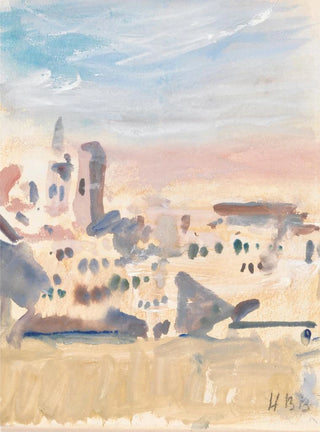Art print | View of a city - Hercules Brabazon Brabazon


View from behind

Frame (optional)
The canvas "Vue d'une ville" by Hercules Brabazon Brabazon evokes an atmosphere that is both serene and vibrant, capturing the essence of a metropolis through the lens of a unique artistic sensibility. This artwork, although from a bygone era, manages to establish a timeless dialogue between the viewer and the urban landscape it depicts. Immersing oneself in this scene, one can feel the hustle of the streets, the murmur of passersby, and the gentle light caressing the facades of buildings. The art print of this piece offers a valuable opportunity to explore the subtleties of city life while paying tribute to the vision of an artist whose perspective on the world continues to fascinate.
Style and uniqueness of the artwork
Hercules Brabazon Brabazon's style is distinguished by an approach that is both realistic and impressionistic. In "Vue d'une ville," he manages to blend elements of architectural precision with a touch of artistic blur, creating an atmosphere that transcends mere representation. The colors, both vivid and nuanced, evoke the variations of light throughout the day, while the details of buildings and streets reflect meticulous observation. The artist skillfully plays with perspectives, offering the viewer a panoramic view that invites exploration. Every element of the composition seems to tell a story, reinforcing the idea that each city is a microcosm of human experiences.
The artist and his influence
Hercules Brabazon Brabazon, a prominent figure of the 19th century, is often recognized for his ability to capture the essence of urban and natural landscapes. His artistic journey, marked by constant evolution, places him at the crossroads of several artistic movements. Influenced by Impressionism and Realism, he developed a style that is uniquely his own, combining traditional techniques with innovations. His work not only enriched the artistic heritage of his time but also paved the way for many contemporary artists. The way he translated the emotions and atmospheres of the places he painted continues to inspire and influence future generations.

Matte finish

View from behind

Frame (optional)
The canvas "Vue d'une ville" by Hercules Brabazon Brabazon evokes an atmosphere that is both serene and vibrant, capturing the essence of a metropolis through the lens of a unique artistic sensibility. This artwork, although from a bygone era, manages to establish a timeless dialogue between the viewer and the urban landscape it depicts. Immersing oneself in this scene, one can feel the hustle of the streets, the murmur of passersby, and the gentle light caressing the facades of buildings. The art print of this piece offers a valuable opportunity to explore the subtleties of city life while paying tribute to the vision of an artist whose perspective on the world continues to fascinate.
Style and uniqueness of the artwork
Hercules Brabazon Brabazon's style is distinguished by an approach that is both realistic and impressionistic. In "Vue d'une ville," he manages to blend elements of architectural precision with a touch of artistic blur, creating an atmosphere that transcends mere representation. The colors, both vivid and nuanced, evoke the variations of light throughout the day, while the details of buildings and streets reflect meticulous observation. The artist skillfully plays with perspectives, offering the viewer a panoramic view that invites exploration. Every element of the composition seems to tell a story, reinforcing the idea that each city is a microcosm of human experiences.
The artist and his influence
Hercules Brabazon Brabazon, a prominent figure of the 19th century, is often recognized for his ability to capture the essence of urban and natural landscapes. His artistic journey, marked by constant evolution, places him at the crossroads of several artistic movements. Influenced by Impressionism and Realism, he developed a style that is uniquely his own, combining traditional techniques with innovations. His work not only enriched the artistic heritage of his time but also paved the way for many contemporary artists. The way he translated the emotions and atmospheres of the places he painted continues to inspire and influence future generations.






